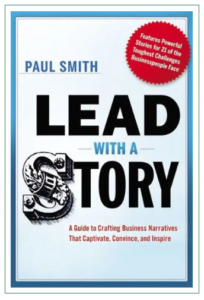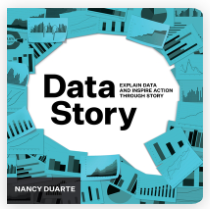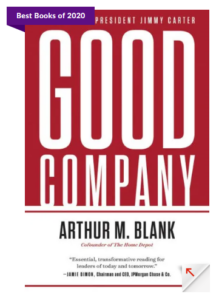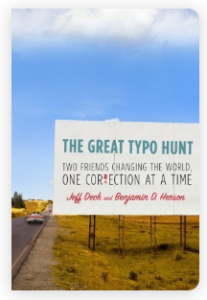The Books I’m Reading Next
As a kid, I devoured books. In middle school, my English teacher, Mrs. Bracken, and I exchanged books frequently. (I think that may have been the only class that I ever sat in the front row.) While I don’t read as much as 13-year-old Ryan, I still love getting lost in stories, learning from smart people, and improving my life and business with others’ insights and lessons.

Lead with a Story: A Guide to Crafting Business Narratives That Captivate, Convince, and Inspire
Paul Smith
“Leadership starts with storytelling.
“With clarity around your message, you will energize those you lead and create a vision they can buy into. But first, you must first write the story that will get them excited and ready to execute.
“Clarity is key for any successful leader, so much so that top corporations, such as Microsoft. Nike, Proctor and Gamble, Kimberly Clark, and many more, have incorporated storytelling into their leadership training programs. These companies know that before you can become a strong leader, you must first master the art of storytelling so you can communicate your vision to your team and inspire them to execute on objectives.”
“…anyone could pick up the book, understand the actionable advice, and begin telling their own stories right away.” — SalesEngine.com

DataStory: Explain Data and Inspire Action Through Story
Nancy Duarte
“Almost every part of an organization today uses data for decision-making. But how effectively is your team using that data to communicate problems or opportunities? Through DataStory, you’ll discover how to explain data through the lens of empathy, so you can transform numbers into persuasive narratives. By learning how to apply story principles to your data, you can communicate essential insights from data to speed up decision-making and influence action.”
“In an age where we are overwhelmed with data, telling a compelling data story is hard. What Duarte has done beautifully is help us connect with an audience on a much more meaningful level. It’s a must-read for business storytellers everywhere who want to make a difference with their work.” — Jeremy Waite, Chief Customer Officer at IBM iX

Good Company
Arthur M. Blank
“The Home Depot co-founder and owner of the NFL’s Atlanta Falcons and MLS’s Atlanta United shares a vision and a roadmap for values-based business.
“Arthur M. Blank believes that for good companies, purpose and profit can-and should-go hand in hand. And he should know. Together with cofounder Bernie Marcus, Blank built The Home Depot from an idea and a dream to a $50 billion-dollar company, the leading home improvement retailer in the world. And even while opening a new store every 42 hours, they never lost sight of their commitment to care for their people and communities. In fact, in 2001, The Home Depot was voted America’s most socially responsible company.
“Blank left The Home Depot that same year with a burning question: Could the values and culture that made that company great be replicated? Good Company takes readers inside the story of how he did just that-turning around a struggling NFL team, rebooting a near-bankrupt retail chain, building a brand-new stadium, revitalizing a blighted neighborhood, launching a startup soccer club, and more.
“‘When good companies put the wellbeing of their customers, their associates, and their communities first, financial success will follow,’ Blank writes. ‘The entrepreneurs and business leaders of today and tomorrow have an extraordinary opportunity: to prove that through upholding values we can create value-for the company, for the customer, and for the community.'”
“We in Atlanta were just blessed when Arthur came here with his courageous vision for business. He knows that the solutions that work are the ones where everybody wins. That’s one of his secrets: He’s mastered the art of the win-win solution.” — Andrew Young, Chairman, Andrew J. Young Foundation

The Great Typo Hunt
Jeff Deck & Benjamin D. Herson
“The signs of the times are missing apostrophes.
“The world needed a hero, but how would an editor with no off-switch answer the call? For Jeff Deck, the writing was literally on the wall: ‘NO TRESSPASSING.’ In that moment, his greater purpose became clear. Dark hordes of typos had descended upon civilization… and only he could wield the marker to defeat them.
“Recruiting his friend Benjamin and other valiant companions, he created the Typo Eradication Advancement League (TEAL). Armed with markers, chalk, and correction fluid, they circumnavigated America, righting the glaring errors displayed in grocery stores, museums, malls, restaurants, mini-golf courses, beaches, and even a national park. Jeff and Benjamin championed the cause of clear communication, blogging about their adventures transforming horor into horror, it’s into its, and coconunut into coconut.
“But at the Grand Canyon, they took one correction too far: fixing the bad grammar in a fake Native American watchtower. The government charged them with defacing federal property and summoned them to court—with a typo-ridden complaint that claimed that they had violated ‘criminal statues.’ Now the press turned these paragons of punctuation into ‘grammar vigilantes,’ airing errors about their errant errand.
“The radiant dream of TEAL would not fade, though. Beneath all those misspelled words and mislaid apostrophes, Jeff and Benjamin unearthed deeper dilemmas about education, race, history, and how we communicate. Ultimately their typo-hunting journey tells a larger story not just of proper punctuation but of the power of language and literacy—and the importance of always taking a second look.”
“This pair of kooks, with their high standards and principled civil disobedience, give me hope for the future of humanity.” — Steven Pinker, Harvard College Professor, Harvard University, and author of The Language Instinct and The Stuff of Thought
